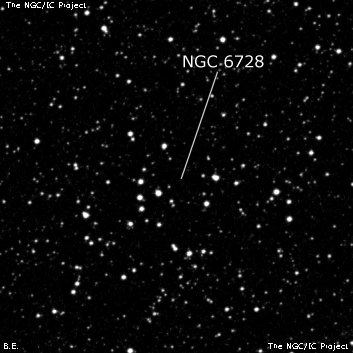NGC/IC Project Restoration Effort
(This is a very very beta version)
NGC6728


Basic Information
Location and Magnitude
Right Ascension: 19:0:14.0
Declination: -8:57:26
Constellation: SCT
Visual Magnitude:
Historic Information
Discoverer: Herschel W.
Year of discovery: 1784
Discovery aperture: 18.7
Observational
Summary description: Cl, vL, P
Sub-type: *Grp
Corwin's Notes
=====
NGC 6728 could be Isserstedt 662, a stellar ring (though it does not look very
ring-like to me). This is one minute, 13 seconds preceding and 1.6 arcminutes
north of WH's position at which there is nothing resembling a cluster. WH
describes his object as being composed of "... coarsely scattered stars, not
rich." This certainly fits Isserstedt 662 which is the only object in the
area that WH might have picked up.
Those interested in Schmidt-Kaler and Isserstedt's idea that the stellar rings
have a constant size -- so can therefore be used as distance indicators -- can
read more about them in A&A 9, 70, 1970 which gives other earlier references.
Note added in February 2013: Well, Isserstedt 662 is not the only "cluster"
that WH could have picked out. About half a minute of time east and three
arcminutes south is a scattered group of stars approximately 14' x 7' across
that actually better matches his description. This is now my prime candidate
for his cluster. I would be surprised if it turned out to be a real cluster,
but it at least has the appearance that might attract the eye of someone
scanning the sky.
By the way, Brent Archinal's Webb Society monograph mentions a November 1988
letter of mine to him in which I credit Alister Ling with the Isserstedt 662
suggestion (Brian Skiff passed this on to me from Alister). In their "Star
Clusters" book, Archinal and Hynes identify the cluster with Isserstedt 662,
but list an incorrect position, and make its size 18 arcminutes, while the
ring catalogue has its size as 2.2' x 1.4', elongated in PA = 120 degrees.
It's possible that they were looking at a different "cluster."
Steve's Notes
=====
NGC 6728
17.5" (7/27/95): large, scattered group of mag 11-14 stars in a 7' triangular outline. Fairly easy to pick out at 100x. There are no rich clumps but many stars are arranged in strings and loops, forming the outline. A small equilateral triangle of mag 12 stars with sides ~30" is situated at the center of the group. Listed as nonexistent in RNGC.



